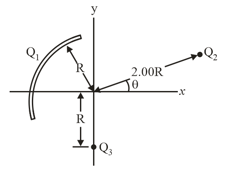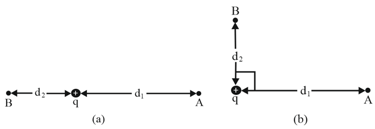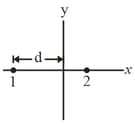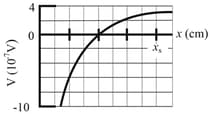What is the excess charge on a conducting sphere of radius if the potential of the sphere is and at infinity?

Important Questions on Electric Potential
The electric field in a region of space has the components and . The point is on the axis at and the point is on the axis at . What is the potential difference (in volt)?
In the figure, a plastic rod which has a uniformly distributed charge has been bent into a circular arc of a radius and the central angle . With at infinity, what is the electric potential at , the centre of curvature of the rod?

In the given figure, what is the net electric potential at the origin due to the circular arc of charge , the two particles of charges and ? The arc's centre of curvature is at the origin and its radius is , the angle indicated is . What is the net electric potential at the origin if both and are doubled?

Consider a particle with charge , point at distance from and the point at distance . If and are diametrically opposite to each other as in the figure, (a) what is the electric potential difference ? (b) what is the electric potential difference if and are located as in the figure (b)?

The electric potential at points in an plane is given by, . What are,
(a) the magnitude and (b) the angle (relative to ) of the electric field at the point ?
Two charged particles are shown in figure. (a) Particle , with charge , is fixed in place at distance . Particle , with charge , can be moved along the -axis. Figure (b) gives the net electric potential at the origin due to the two particles as a function of the -co-ordinate of particle . The scale of the -axis is set by, . The plot has an asymptote of as . What is in terms of ?


An infinite non-conducting sheet has a surface charge density, .
(a) How much work is done by the electric field due to the sheet if a particle of charge, is moved from the sheet to a point at distance, from the sheet?
(b) If the electric potential is defined to be on the sheet, what is at ?
